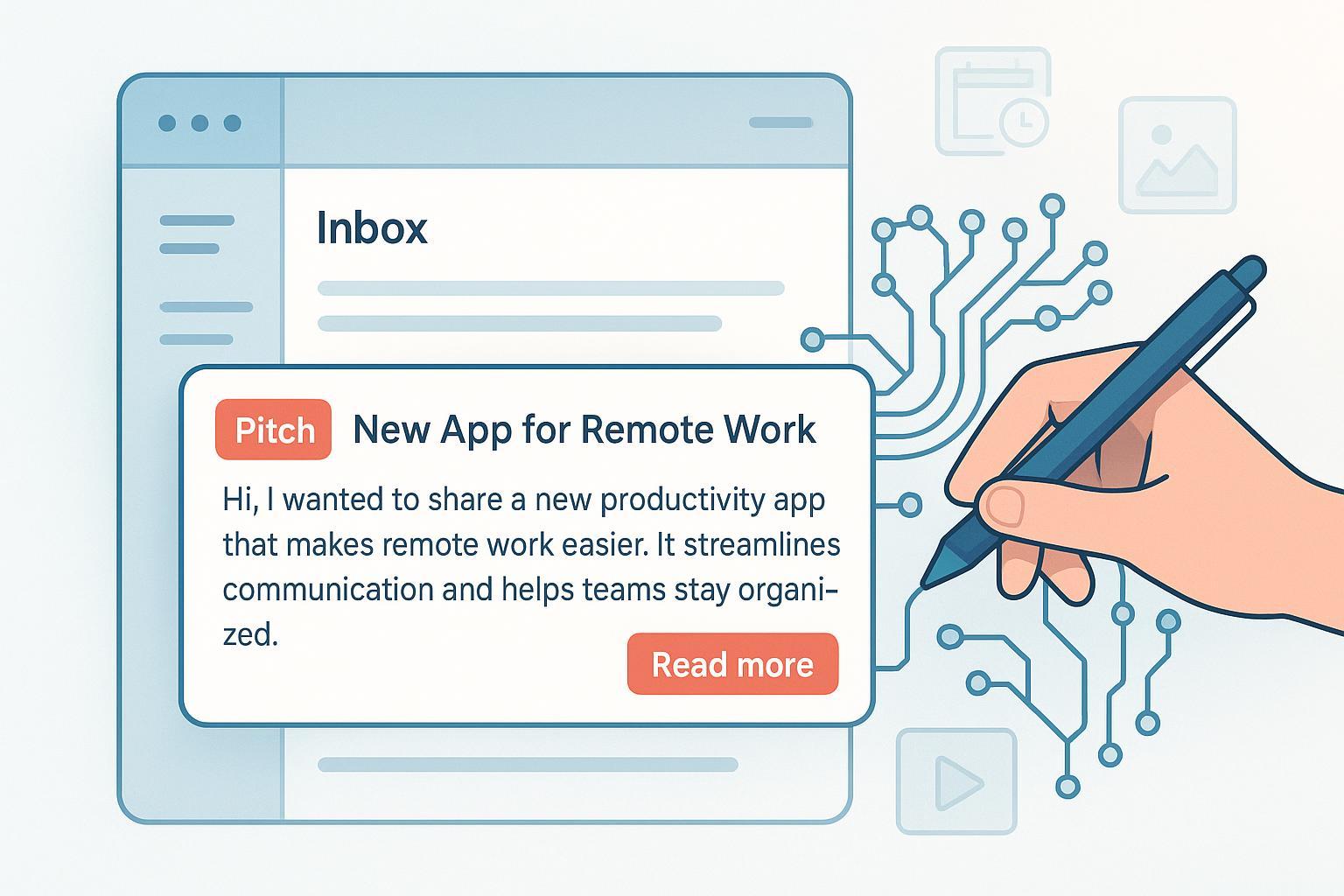AI PR Pitching Best Practices (2025): Scale Personalization Without Losing the Human Touch

If your pitches feel faster but not better, this playbook is for you. Below is a practitioner’s guide to integrating AI into PR pitching—step by step—so you can increase relevance, add multimedia, and time outreach smarter, while staying ethical and relationship-first.
What “good” looks like in 2025
- Relevance is non‑negotiable. In its global survey of 3,000+ journalists, Cision’s 2025 State of the Media highlights that irrelevance remains the top reason pitches get ignored; the report also underscores the scale of noise in journalists’ inboxes (press release published in 2025 via PR Newswire). See the summary in the Cision 2025 State of the Media press release and the Cision lessons recap.
- Email remains the dominant channel and shorter is better. Cision’s pitching guidance in 2025 points to email as the preferred channel and recommends tight word counts (roughly 100–300 words) for initial pitches; see Cision’s follow-up guide (2025) and Cision’s PR writing tips (2025).
- Journalists use AI too. A 2025 panel recap indicates widespread AI adoption among journalists, with an emphasis that tailored, timely, beat‑relevant pitches still win attention; see the WNA News summary of a Muck Rack panel (2025).
- Subject lines matter. Practitioner recaps in 2025 reiterate that subject lines heavily influence outcomes; see PRNewsOnline’s 2025 perspective on what journalists value most.
Bottom line: Use AI to scale research and drafting, but keep a tight human filter on relevance and tone.
Workflow 1: Research the reporter and shape the angle (AI + HITL)
Objective: Build a one‑page brief per target journalist in 8–10 minutes, then choose a single, timely angle.
Steps:
- Pull recent coverage (last 60–90 days): titles, summaries, and any recurring themes or beats.
- Ask AI to extract patterns: what topics this journalist advances, what contrarian views they’ve explored, and what data they cite.
- Cross‑check for dealbreakers: prior critiques of your category, conflicts of interest, or coverage fatigue.
- Draft 1–2 angle hypotheses mapped to their beat and audience; identify a supporting data point or expert you can offer.
- Human-in-the-loop review: sanity‑check facts, correct jargon, and vet tone.
Try this prompt to create a reporter brief:
Task: Build a reporter brief to inform a personalized PR pitch.
Inputs: Paste 5–8 recent article titles + links for one journalist.
Output: 1-page brief with:
- Beat and sub-topics in their words
- Themes they return to + contrarian takes
- Data sources they cite (studies, companies, public datasets)
- Gaps or follow-up angles they might explore next
- Red flags (conflicts, coverage fatigue, prior critiques)
- 2 pitch angles tied to their beat, each with a credible supporting data point I can provide
Constraints: Use neutral language; do not fabricate sources; flag any uncertainty.
Human verification checklist (2 minutes):
- Does the angle directly connect to a story this journalist has recently advanced?
- Can you back claims with verifiable data or a real customer/expert?
- Is there a new element (data point, access, case study) that justifies coverage now?
Why it works: You’re using AI to compress research time, then applying editorial judgment to ensure fit. This aligns with 2025 journalist expectations about relevance and timeliness described in Cision’s State of the Media materials.
Workflow 2: Draft a 150–200‑word pitch with evidence and a single CTA
Structure your email like this:
- Subject: One clear benefit or news hook; no clickbait.
- Opening line: Personal proof you read their work (reference a recent article and why your angle advances it).
- Value in bullets: 2–3 bullets with the news angle, credible data, and access you can offer (exec, customer, brief, embargoed deck).
- CTA: One option—offer a quick call, interview, or an exclusive.
- Assets: Link to a lightweight media kit (not attachments).
Annotated template:
Subject: New data on {specific trend} your {Month dd story} was probing
Hi {First Name},
I appreciated your {Outlet} piece on {specific angle}; your point about {short reference} matches what we’re seeing across {sector/market}.
If you’re exploring a follow-up, I can offer:
- Fresh {dataset/benchmark}: {one-sentence finding; include timeframe + sample size if applicable}
- Access: {Exec/Customer Name & Title} for 15 min on {date range}
- Visuals: Link-only media kit with charts, product shots, and 30-sec b-roll
Would {Tue–Wed, time zone aware} work for a quick call? Happy to send the deck under embargo if easier.
Best,
{Name}, {Role}
{Phone}
{Media kit URL}
Two subject line variants to A/B:
- “Exclusive access: {dataset} on {beat topic}, {Month 2025}”
- “Following your {Outlet} piece: new {angle} with {exec/customer} available”
Cite credible sources in your bullets. If you reference industry context, anchor it with a primary link. For instance, if discussing earned media’s impact on AI answers, you can note 2025 findings that generative AI leans heavily on unpaid sources and link to the Muck Rack study reporting 95% of citations from unpaid media (2025).
Multimedia that earns attention (without clogging inboxes)
Journalists reward pitches that make storytelling easier. Provide assets via a link to a media kit—avoid heavy attachments.
Include in your kit:
- 2–3 approved product or context images (hero + detail)
- 20–30 seconds of b‑roll or a short explainer clip
- 1–2 charts or infographics with source notes
- Executive headshot and one‑paragraph bio
- Fact sheet and concise boilerplate
Engagement evidence: While the oft‑cited “9.7x more views” stat for multimedia releases is widely referenced, always seek the primary study before asserting precise multipliers. A practical 2025 resource is the PR Newswire multimedia content guide (2025), which outlines why visuals increase discoverability and usefulness for journalists. Case discussions also suggest uplift from multimedia; see this Communiqué PR explanation referencing Business Wire outcomes.
Tip: Host your kit on a newsroom or a clean landing page; avoid expiring links and require no login.
Predictive angles and timing: Let AI narrow the window, you make the call
Use AI to spot narrative momentum and optimal outreach windows—then apply editorial judgment.
- Trend detection and timing: Suites like Cision and Meltwater emphasize predictive analytics to spot emerging topics and recommend timing windows. See Cision’s product family overview and Meltwater’s 2025 Mira announcement alongside its GenAI Lens launch.
- Align with AI search narratives: Muck Rack’s Generative Pulse aims to show which sources shape LLM answers—helpful for choosing angles and targets that echo in AI search. See Capitol Communicator’s 2025 coverage of Generative Pulse.
Practical timing heuristics:
- Pitch during the recipient’s workday, respecting their timezone and publishing cadence.
- Mid‑week late mornings often perform better anecdotally, but your beat and outlet rhythm matter more than day‑of‑week lore. Keep notes by reporter.
Follow‑up discipline: Fewer, better, opt‑out friendly
- One thoughtful follow‑up 3–5 business days later is usually enough.
- Move the story forward in the follow‑up—add a fresh data point, an available customer, or a tighter angle.
- Honor opt‑outs quickly and cleanly. Keep your list updated to avoid repeat irrelevance.
Follow‑up template:
Subject: Quick follow-up: {specific angle} + {new data point/customer}
Hi {First Name},
Circling back on the {angle} I shared last week. New since then:
- {Short, verifiable update}
- {Confirmed availability: exec/customer}, {dates}
If it’s not a fit, no worries—happy to remove you from this thread.
Thanks,
{Name}
For channel and brevity expectations, see 2025 guidance that email is still preferred and concise messages work best in practice; Cision offers reminders in its pitching and follow‑up content (2025).
Measurement that reflects outcomes (not just opens)
Anchor your evaluation to the AMEC Integrated Evaluation Framework and the Barcelona Principles v4.0.
- Frameworks: AMEC’s 2025 summit programming reiterates outcome‑based approaches; see the AMEC 2025 programme. For a practitioner explainer of Barcelona Principles v4.0, see FullIntel’s 2025 guide.
Map to the funnel:
- Outputs: Pitches sent, list quality, media kit completeness.
- Outtakes: Opens, reply rate, journalist quality, meeting set.
- Outcomes: Articles/segments, message pull‑through, share of voice, backlink quality.
- Impact: Referral traffic and conversions, influenced pipeline, and—new in 2025—visibility in AI answers or citations in LLM outputs.
Practical metrics to track per campaign:
- Targeted list precision (% on‑beat, verified contacts)
- Response rate by beat and by angle
- Time‑to‑first‑placement (days)
- Placement quality (DA/DR, reach, sentiment)
- AI search presence (brand/topic shows up in LLM answers; key outlet citations)
Ethics and disclosure: Guardrails that protect trust
Set and share a lightweight policy for AI use in pitching. Core pillars:
- Human-in-the-loop editing: Always fact‑check and verify sources before sending. This is echoed in a 2025 white paper aligned with PRSA/CIPR principles; see the LLPR AI White Paper (2025) on disclosure and HITL.
- Transparency when material: If AI meaningfully shaped the content or data synthesis, be ready to disclose on request.
- Bias and privacy checks: Collaborate with legal/IT to avoid bias propagation and protect data. See the Global Alliance 2025 dialogue on responsible AI and a practitioner explainer on ethical AI use in PR from Cutting Edge PR (2025).
Toolbox: Neutral picks to operationalize AI pitching
Disclosure: The list below includes our own product alongside independent tools; we identify it clearly and present it neutrally.
- Cision (CisionOne): AI‑assisted media database, list building, monitoring, and predictive insights; useful for identifying trending angles and measuring impact. See Cision’s official site.
- Muck Rack: Media database and outreach workflows, plus Generative Pulse to understand sources shaping LLM answers. See Capitol Communicator’s 2025 overview.
- Meltwater: Monitoring and analytics with 2025 AI features (Mira assistant and GenAI Lens) for predictive detection and AI search monitoring. See Mira and GenAI Lens.
- BuzzSumo: Topic and trend discovery, journalist/influencer identification based on engagement; helpful for angle selection. See the State of Digital Publishing tools overview.
- Prowly: Budget‑friendly PR suite with AI‑enhanced release drafting and outreach analytics. See Prowly Magazine’s 2025 AI tools roundup.
- QuickCreator: AI‑enabled content and blog creation with SEO optimization and fast, on‑brand newsroom/press page publishing; helpful for hosting media kits and lightweight press resources. Disclosure: QuickCreator is our product.
How to choose: Prioritize database quality for your beats, the clarity of analytics, and ease of exporting/hosting clean media kits.
Micro‑example: Host a clean media kit fast
Use a content tool to create a press‑ready media kit page in minutes. For instance, teams use a blog‑style builder to:
- Spin up a dedicated “Press” page with sections for Fact Sheet, Visuals, Contacts, and Boilerplate.
- Embed images and a short clip via links; keep file sizes web‑friendly and include source notes under each chart.
- Publish the page to a stable URL and reuse it across outreach, updating assets centrally.
One way to do this is with a page builder that supports block layouts, multimedia embedding, and one‑click publishing—like QuickCreator or a CMS you already use. Keep the language neutral and the assets journalist‑ready.
Troubleshooting: Fix these five common AI pitching failures
- Robotic tone and generic flattery
- Symptom: “Loved your recent article on innovation.” No specifics.
- Fix: Force a citation to a specific line or finding and explain how your data advances it. Add a single sentence demonstrating you understand their audience.
- Over‑automation and list bloat
- Symptom: Hitting 300 contacts with a semi‑relevant angle and hoping something sticks.
- Fix: Cap each wave to a small, high‑fit segment. Require a manual sign‑off on angle‑to‑reporter fit before sending.
- Hallucinated facts or mislabeled sources
- Symptom: AI adds a stat without a primary source.
- Fix: Implement a “no source, no send” rule. Every stat must be linked to a primary or canonical source in the pitch or your media kit. For example, when referencing AI‑era earned media impact, cite the Muck Rack earned‑media weighting study (2025).
- Asset overload
- Symptom: Big attachments; drive links that require permission.
- Fix: Use a single, public media kit URL with thumbnails, captions, and download options. Keep it under 5–7 total assets.
- Timing misses
- Symptom: Pitches arrive outside working hours or when the beat is saturated.
- Fix: Use predictive and monitoring tools to track narrative momentum, then schedule respectfully in the journalist’s timezone. Blend tech signals with your editorial sense.
Implementation checklist
- [ ] For each reporter, build a one‑page brief and validate angles
- [ ] Draft 150–200‑word pitches with a single CTA and link‑only assets
- [ ] Host a stable media kit page with current visuals and bios
- [ ] Use predictive tools for timing; log outcomes by beat
- [ ] Follow up once with net‑new value; respect opt‑outs
- [ ] Measure outcomes via AMEC/Barcelona mapping and AI‑era proxies
- [ ] Apply a documented AI policy: HITL, disclosure, bias/privacy checks
Final thought
AI should compress the busywork and sharpen your angle—not replace editorial judgment or relationships. Keep your promise to journalists: a relevant, timely pitch that makes their story better. Do that consistently, and the tech becomes a force multiplier rather than a shortcut.

